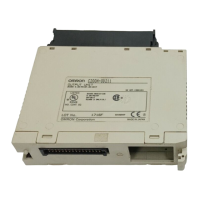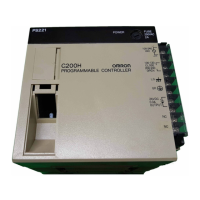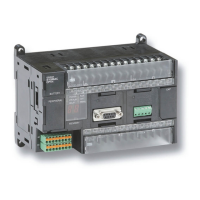4
1–4 OMRON Product Terminology
OMRON products are divided into several functional groups that have ge-
neric names. A
ppendix A
Standard Models
list products by these groups.
The term Unit is used to refer to all OMRON PC products, depending on the
context.
The largest group of OMRON products is I/O Units. I/O Units come in a vari-
ety of point quantities and specifications.
Special I/O Units are dedicated Units that are designed to meet specific
needs. These include Analog Timer Units and Analog I/O Units.
Link Units are used to create Link Systems that link more than one PC or
link a single PC to remote I/O points. Link Units include I/O Link Units that
are used to connect P-type PCs to Remote I/O Systems controlled by a larg-
er PC (e.g. C1000H) and Host Link Units.
Other product groups include Programming Devices, Peripheral Devices,
and DIN Rail Products.
1–5 Overview of PC Operation
The following are the basic steps involved in programming and operating a
P-type PC. Assuming you have already purchased one or more of these
PCs, you must have a reasonable idea of the required information for steps
one and two, which are discussed briefly below. This manual is written to ex-
plain steps three through six, eight, and nine. The section(s) of this manual
that provide relevant information are listed with each of these steps.
1. Determine what the controlled system must do, in what order, and at
what times.
2. Determine what Units will be required. Refer to the
Installation Guide
. If
a Link System is required, refer to the required
System Manual(s)
.
3. On paper, assign all input and output devices to I/O points on Units and
determine which I/O bits will be allocated to each. If the PC includes
Special I/O Units or Link Systems, refer to the individual
Operation
Manuals
or
System Manuals
for details on I/O bit allocation. (
Section 3
Memory Areas)
4. Using relay ladder symbols, write a program that represents the se-
quence of required operations and their inter-relationships. Be sure to
also program appropriate responses for all possible emergency situ-
ations. (
Section 4 Programming, Section 5 Instruction Set, Section 6
Program Execution Timing)
5. Input the program and all required operating parameters into the PC.
(
Section 7 Program Input, Debugging, and Execution
)
6. Debug the program, first to eliminate any syntax errors and then to elim-
inate execution errors. (
Section 7 Program Input, Debugging, and Exe-
cution
and
Section 8 Troubleshooting
)
7. Wire the PC to the controlled system. This step can actually be started
as soon as step 3 has been completed. Refer to the
Installation Guide
and to
Operation Manuals
and
System Manuals
for details on individual
Units.
8. Test the program in an actual control situation and fine tune it if required.
(
Section 7 Program Input, Debugging, and Execution
and
Section 8
Troubleshooting
)
9. Record two copies of the finished program on masters and store them
safely in different locations. (
Section 7 Program Input, Debugging, and
Execution
)
1, 2, 3...
Overview of PC Operation Section 1–5

